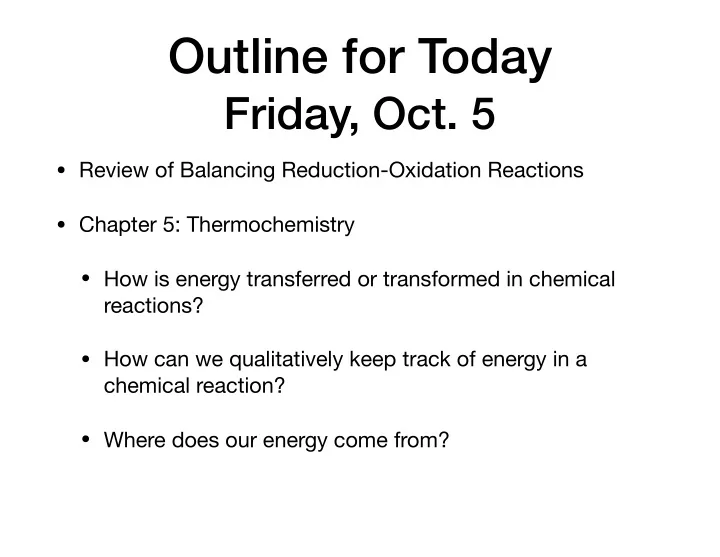

Outline for Today Friday, Oct. 5 • Review of Balancing Reduction-Oxidation Reactions • Chapter 5: Thermochemistry • How is energy transferred or transformed in chemical reactions? • How can we qualitatively keep track of energy in a chemical reaction? • Where does our energy come from?
Balancing Redox Half Reactions (Section 20.2) • Example 1. Balance: Cu(s)+NO 3- → Cu 2+ (aq) +NO 2 (g) • Example 2. Balance: MnO 4- (aq) + C 2 O 42- (aq) → Mn 2+ (aq) + CO 2 (g)
Balancing Redox Reactions 1. Separate total reaction into two half reactions . 2. Assign Oxidation Numbers to each atom 3. Balance each half reaction: A. Balance all elements besides H and O B. Balance O by adding H 2 O C. Balance H by adding H + D. Balance charge by adding e - 4. Multiply half reactions by integers so that half reactions have equal number of electrons 5. Add the half reactions and simplify !
Determining Oxidation Numbers Oxidation Number Species Elemental Atoms 0 Charge on Ion Monoatomic Ion “+1 Hydrogen Bonded to Nonmetal Hydrogen Bonded to Metal -1 Oxygen Usually -2 Fluorine -1 Other Halogens Usually -1 Neutral Molecule Sum of Oxidation Numbers is 0 Polyatomic Ion Sum of Oxidation Numbers is Ion charge
O 2 (g) + 4H + (aq) + 4e - → 2H 2 O (l)
Reduction-Oxidation Reactions are the Reactions that Sustain Life We Burn Fuels: C 6 H 12 O 6 + 6 O 2 → 6 CO 2 + 6 H 2 O Oxidation 0 +1 -2 +4 -2 Numbers: Plants Make Fuels from Solar Energy: 6 CO 2 + 6 H 2 O → C 6 H 12 O 6 + 6 O 2
Recommend
More recommend